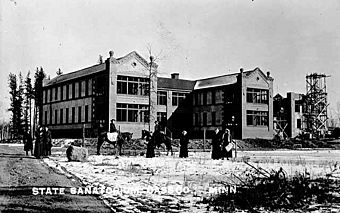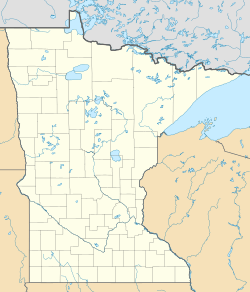Minnesota State Sanatorium for Consumptives facts for kids
|
Minnesota State Sanatorium for Consumptives
|
|
|
Formerly listed on the U.S. National Register of Historic Places
|
|

Part of the Minnesota State Sanatorium for Consumptives under construction c. 1910
|
|
| Nearest city | Walker, Minnesota |
|---|---|
| Area | 176.2 acres (71.3 ha) |
| Built | 1906 |
| Architect | Clarence H. Johnston, Sr.; et al. |
| Architectural style | Colonial Revival, Tudor Revival, et al. |
| NRHP reference No. | 01000766 |
Quick facts for kids Significant dates |
|
| Added to NRHP | July 25, 2001 |
| Removed from NRHP | May 28, 2019 |
The Minnesota State Sanatorium for Consumptives was a special hospital opened in 1907. It was also known as the Ah-Gwah-Ching Center. The name "Ah-Gwah-Ching" means "out-of-doors" in the Ojibwe language. This center helped people who had tuberculosis, a serious lung disease.
The hospital treated nearly 14,000 patients until January 1, 1962. After that, it became a nursing home called the Ah-Gwah-Ching Nursing Home. It cared for older patients with different health issues. In the 1970s, it had as many as 462 patients.
Contents
Why Was the Sanatorium Built?
In the late 1800s, many people in Minnesota died from tuberculosis. More than 20,000 people died between 1887 and 1899. At that time, doctors believed that fresh air and a healthy place could help patients. This was thought to make the body's defense system stronger.
Since there were no good medicines yet, hospitals called sanatoria were built. These places helped to separate and treat patients. This was done to stop the disease from spreading.
Building the Ah-Gwah-Ching Center
Construction for the Minnesota State Sanatorium began in 1906. It was built about 3 miles (5 km) south of Walker. The hospital overlooked Shingobee Bay on the south shore of Leech Lake.
Over time, it grew into a large group of unique buildings. These buildings showed different styles of architecture. Some styles included Colonial Revival, Tudor Revival, and Spanish Colonial Revival.
How Tuberculosis Was Treated
The sanatorium used new ways to treat tuberculosis as they were discovered. One method was called artificial pneumothorax. This involved gently collapsing a sick lung. It was believed this would stop the disease from growing. Patients would live with one lung while the other healed.
Then, in the 1940s, a big change happened. New medicines called antibiotics were created. These medicines were very good at killing the bacteria that caused tuberculosis. Because of antibiotics, tuberculosis almost disappeared in the U.S. by the 1960s.
The Center's Later Years and Closure
As fewer people got tuberculosis, many special hospitals like this one closed. The Minnesota Sanatorium closed in 1962 after helping almost 14,000 patients. It later reopened as a nursing home.
By 1990, the nursing home had about 300 patients. By 2003, this number dropped to about 150 patients. The center finally closed its doors in 2008.
What Happened to the Buildings?
After the center closed, people tried to find a new use for the buildings. However, no good plan was found. So, in 2010, almost all the buildings were torn down. The site had about 250,000 square feet (23,226 square meters) of buildings.
Only a small gazebo was left standing. The land was then divided up. Cass County government bought 60 acres (24 ha) for new development. The other 50 acres (20 ha) were given to the Minnesota Department of Natural Resources. This part became a place for wildlife.
The facility was added to the National Register of Historic Places in 2001. It was removed from the list in 2019 after the buildings were demolished.
 This article incorporates text from MNopedia, which is licensed under the Creative Commons Attribution-ShareAlike 3.0 Unported License.
This article incorporates text from MNopedia, which is licensed under the Creative Commons Attribution-ShareAlike 3.0 Unported License.



